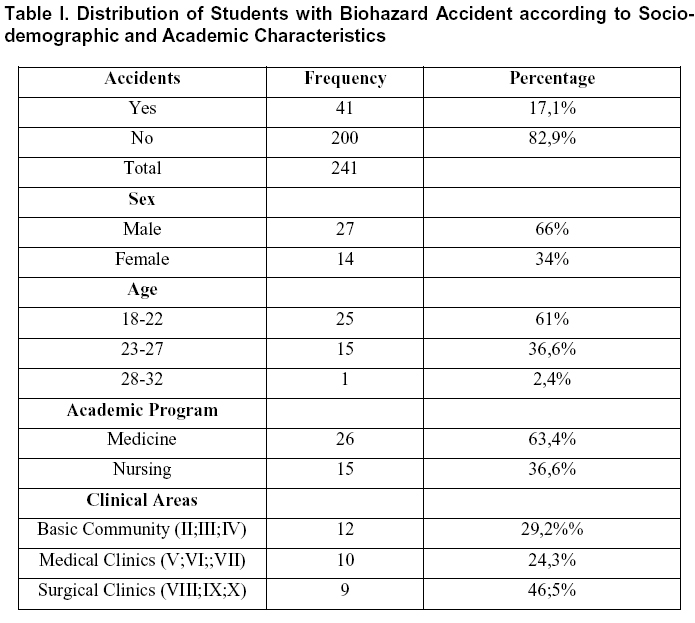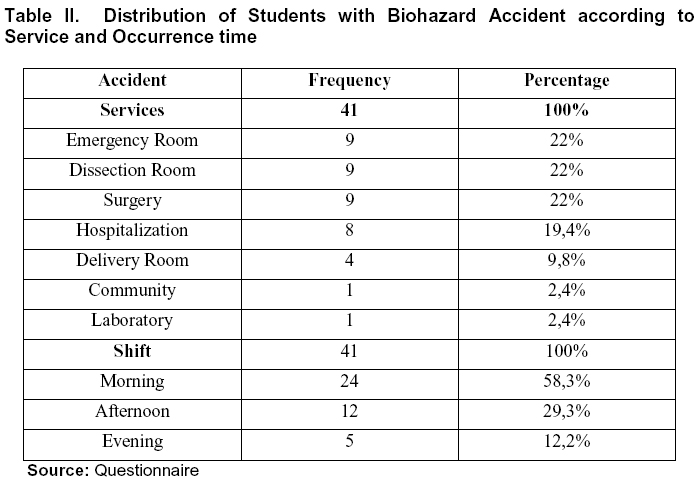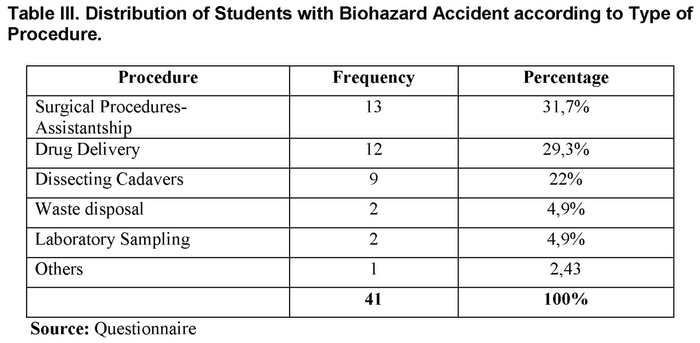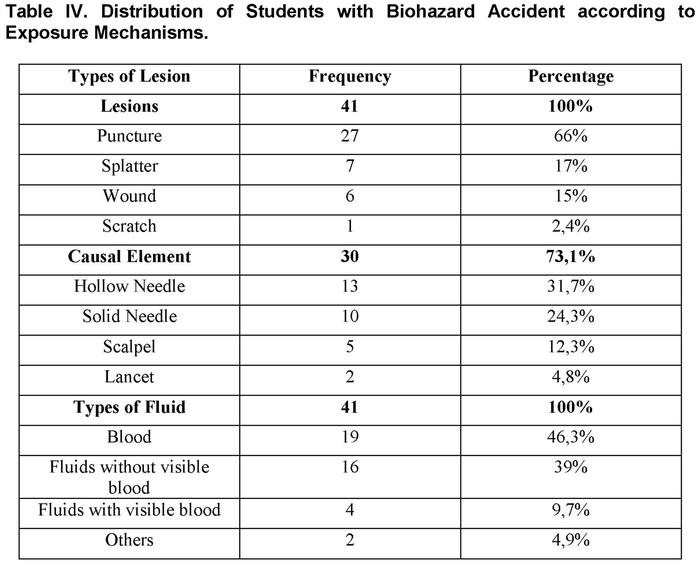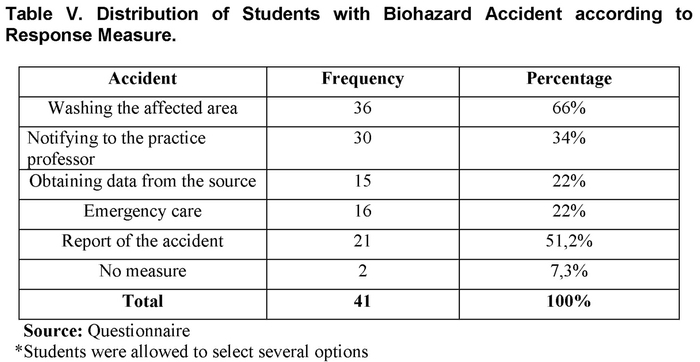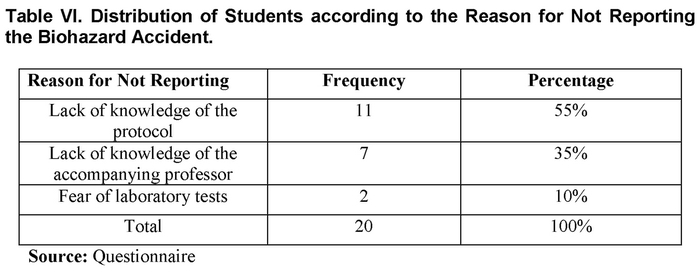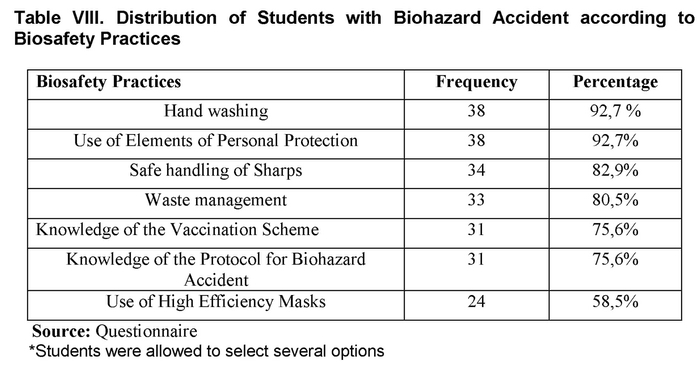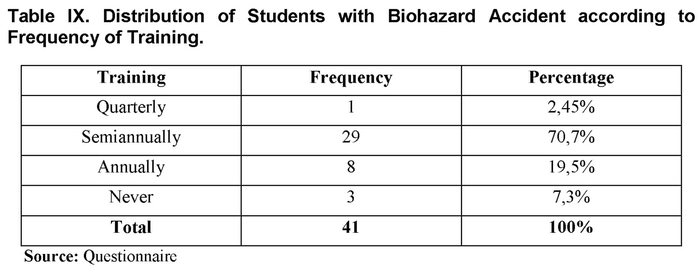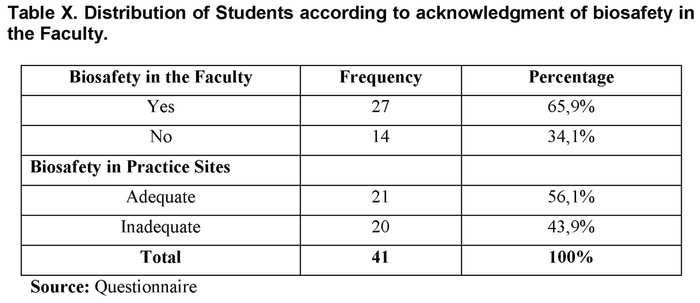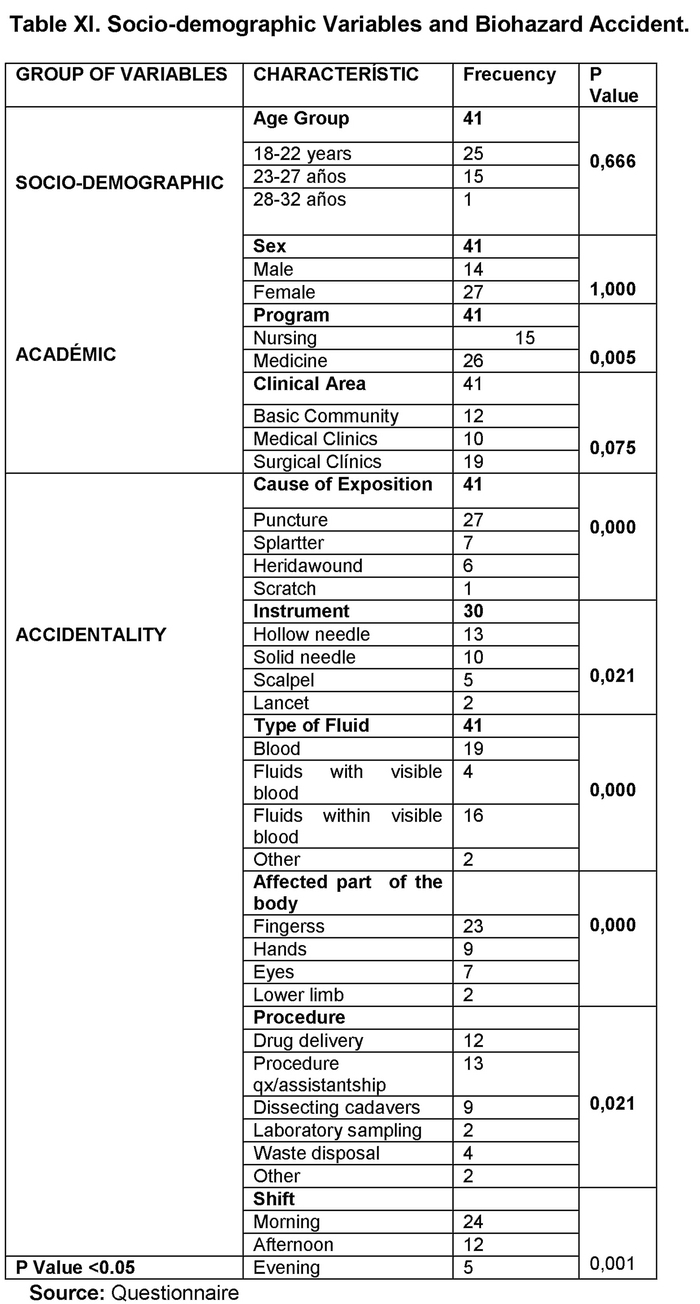My SciELO
Services on Demand
Journal
Article
Indicators
-
 Cited by SciELO
Cited by SciELO -
 Access statistics
Access statistics
Related links
-
 Cited by Google
Cited by Google -
 Similars in
SciELO
Similars in
SciELO -
 Similars in Google
Similars in Google
Share
Enfermería Global
On-line version ISSN 1695-6141
Enferm. glob. vol.15 n.42 Murcia Apr. 2016
DOCENCIA - INVESTIGACIÓN
Study of characterization of biohazard accidents in students of the Faculty of Health Sciences. College Institution. Cali. 2013
Estudio de caracterización de accidentes biológicos en estudiantes de pregrado de la Facultad de Ciencias de la Salud. Universidad Libre. Seccional Cali. 2013
García Gómez, María Mercedes
Professor. Nursing Program. Faculty of Health Sciences. Universidad Libre Seccional Cali. Colombia E-mail: maria.garcia@unilibrecali.edu.com
ABSTRACT
Objectives: To characterize biohazard accidents among students of the Faculty of Health Sciences at the Universidad Libre in the exercise of their clinical practice.
Materials and Methods: A descriptive, quantitative cross-sectional study was performed with the application of a self-administered questionnaire, with voluntary participation of students from thenursing and medicine programs of the Faculty of Health Sciences at the Universidad Libre, in Cali,Colombia.
Results: The results show 17.1% (41) of students with biohazard accidents during care practices. The most common mechanism of transmission was puncturing with sharp objects in upper limb, represented by 65.9% (27); the second mechanism was the exposure of ocular mucous membranes to blood or body fluids, with 17% (7). The area of greatest clinical occurrence was the Surgical Clinics with 46.2% (19), and Basic and Community with 29.3% (12). Medical studentssuffered 63.4% (26) of accidents, while nursing students 36.6% (15). 41.5% (17) received emergency medical care. In 4.9% (2 students), it was considered necessary the use of post-exposure prophylaxis for the accident. As for the site of occurrence, the highest percentage occurred at extramural level, corresponding to health institutions with which the university has agreements for training care practices. Accidents in the dissection room area, 21.9% (9), correspond exclusively to medical students, which is located within the university headquarters. 43.9% (20) of biohazard accidents were not reported by the students who suffered them.
Conclusions: Biohazard accidents are frequent for undergraduate students in clinical areas of Basic and Community, and mostly in Surgical Clinics, probably due to more instrumentation use. 9.5% of students of the faculty does not use any protection. So it is recommended a strengtheningprogram that includes preventing actions and promotion of adherence to the rules of standard caution, monitoring modifications of risk practices aimed at undergraduate students of the Faculty of Health.
Key words: Biological Accidents; Students; Faculty; Medicine; Nursing.
RESUMEN
Objetivos: Caracterizar los accidentes biológicos en estudiantes de la Facultad de Ciencias de la Salud de la Universidad Libre en el ejercicio de la práctica clínica.
Materiales y métodos: Se realizó un estudio descriptivo, cuantitativo de corte transversal mediante la aplicación de un cuestionario autodiligenciado, de participación voluntaria, a estudiantes de los programas de medicina y de enfermería de la Facultad de Ciencias de la Salud de la Universidad Libre de Cali.
Resultados: Los resultados muestran un 17,1% (41) de estudiantes con accidentes biológicos durante las prácticas asistenciales. El mecanismo de transmisión más frecuente fueron los pinchazos con elementos cortopunzantes en miembro superior, representados con el 65,9% (27), el segundo mecanismo fue la exposición a mucosas oculares con sangre o fluidos corporales con un 17% (7). El área clínica de mayor ocurrencia fueron las Clínicas Quirúrgicas con 46,2% (19), Básicas y Comunitarias con un 29,3% (12) .Los estudiantes de medicina sufrieron el 63,4% (26) de los accidentes, mientras que enfermería el 36,6% (15). El 41,5% (17) recibió atención médica de urgencias. En el 4,9% (2) de los estudiantes se consideró como necesaria la utilización de la profilaxis postexposicion al accidente. En cuanto al sitio de ocurrencia el mayor porcentaje fue extramural, correspondiente a las instituciones de salud, con los que la universidad tiene convenios para las prácticas asistenciales formativas. Los accidentes ocurridos en el área de anfiteatro 21,9% (9) corresponden exclusivamente a estudiantes del programa de medicina, el cual está ubicado dentro de las instalaciones de la universidad. El 43,9% (20) de accidentes biológicos no fue reportado por el estudiante que lo padeció.
Conclusiones: Los accidentes biológicos en estudiantes de pregrado son frecuentes en las áreas clínicas de Básicas y Comunitarias, y mayormente en Clínicas Quirúrgicas probablemente por la mayor instrumentación. El 9,5% de los estudiantes de la facultad no utiliza ninguna protección. Por lo que se recomienda, el fortalecimiento de un programa que contemple acciones de prevención y fomento de la adherencia a las normas de precaución estándar con seguimiento en la modificación de las prácticas de riesgo dirigidas a los estudiantes de pregrado de la Facultad de Salud.
Palabras clave: Accidente Biológico; Estudiantes; Facultad; Medicina; Enfermería.
Introduction
The biohazard risk constitutes the most frequent risk of exposure for students in health careers, which influences their lives, and therefore their health and safety (1) considered likely during their formative practice to suffer biohazard accidents due to the inexperience, lack of skills, poor compliance with the rules and low perception of risk (2) added to the contact with blood or other potentially contaminated products, through a percutaneous injury, mucous membrane or non-intact skin in permanent contact with patients potentially infective (3). The literature reports the procedures most often associated with accidents, venipuncture and sutures (4) and as a mechanism of injury, the puncture with needle stick, becoming the highest risk for occupational transmission of blood-borne viruses (5): seroconversion rates after a biohazard accident are low, Human Immunodeficiency Virus (HIV) is 0.3%, for Hepatitis C virus (HCV) is 2% to 3%, for Hepatitis B Virus (HBV) is close to 30%; although there is vaccination for the latter (6). Seroconversion depends on the volume of inoculated body fluid, viral load, the route of inoculation and administration of antiviral prophylaxis following exposure. (7)
Every year there are 500,000 to 600,000 accidents with biohazard risk in the United States, Canada and Germany individually (8). Studies in Colombia are scarce and the findings in biohazard accident studies for students in health careers show prevalence rates that oscillate within a very wide range (4-69%) (9); these figures vary according to the nature of the clinic, whether it is a medical, a surgical or a community one. (10)
This study considered the accident with biohazard as the incidental event that exposes the individual to a disease (11). The Center for Disease Control and Prevention (CDC) define biohazard accidents as an exposition of health personnel to potentially infectious fluids by percutaneous injury, puncture or cut, or contact with mucous membranes or non-intact skin (12). This definition excluded of biohazard accidents, in 2005, contact fluids, even contaminated with blood, or blood itself, with intact skin. (2-4)
To prevent such accidents, it is recommended conducting educational campaigns and awareness about the routine use of elements of individual personal protection, safe handling of sharps, and the knowledge of the "universal precautions" issued by the Center for Disease Control infectious since 1987 (13). The knowledge about mechanisms of transmission, health effects, and methods of prevention and control can help students in health careers, as future health professionals, to become aware and sensitized to the importance and responsibility of creating safe environments. (14-16)
Despite this, in many institutions of higher education the conditions of practical training students are not studied, the risks they are exposed to are not known, and decision-making is not induced in order to prevent biohazard accidents (17,18) . Our institution, and Colombia in general terms, is no exception, since studies about accidents associated to biohazard in undergraduate students in health careers is just emerging, and so are the factors and associated behaviors. (19,20)
The aim of this study was to answer these questions, and characterizing the occurrence of accidents with biohazard, as well as its description in the population of students of the Faculty of Health Sciences, was seen as one of the important factors.
Materials and methods
Type of Study
Quantitative, descriptive, cross-sectional.
Instrument: It was applied an individual filling out questionnaire, for voluntary participation; official authoring and design by Plazas and Aranguren authors, from the UPTC (2002). The questionnaire consists of 28 questions about socio-demographic aspects, characteristics of the accident, care, and biosafety in college.
Population: Students of the academic period 2012-2, second through tenth of medicine program and fourth to ninth nursing program. To determine the number of students enrolled was used to register Academician of the institution. The number of students of the faculty was 1140 for the period.
Sample: The risk for accident was characterized using the following calculation:
The selection of students was conducted by random sampling at each semester in both programs. All the 241 participants in the study answered the survey during the period October to December 2012, at the end of any academic activity. Surveys were given to each participant and collected once filled out.
Inclusion criteria. Students of the Faculty of Health Sciences enrolled in the period 2012-2. Students in the medicine program, from second to tenth semester. Nursing program students, from fourth to ninth semester.
Exclusion criteria. Poorly filled out surveys.
Variables. Socio-demographic variables such as age, gender, health program, semester in which each student was enrolled in. The variables related to the accident: causing agent, type of injury, exposure to body fluids, the affected body part, type of risk, area of occurrence, type of object that caused the accident, immediate causes.
Variables related to biosafety: training in biosafety protocols, biosecurity in the faculty, and the availability of biosafety elements at the practice site.
Techniques for Collection of Information: By an invitation addressed to the volunteer students from each academic program (medicine and nursing), the survey was conducted taking into account the selection of the sample according to the established distribution. The surveys were conducted anonymously; they were self-made, with prior informed consent of the students.
Statistical analysis: Data collected by the measuring instrument were entered in an Excel database. The data analysis was performed on the Epi-info software 6.04d (CDC, USA). The information obtained through the questionnaire was analyzed according to the type of variables.
Ethical considerations: According to Resolution 8430 of 1993, this research can be classified as safe research, according to Article 11, paragraph A. Written, informed consent about participation in the study was obtained for every one of the participating students in the faculty. This study was approved for its implementation by the Ethics Committee for Scientific Research of the Faculty of Health Sciences at the Universidad Libre, Cali District, and the respective authorizations of directors of the Faculty of Health Sciences, among others, the Dean of the Faculty of Health Sciences, the Medicine Program director, and the director of the Nursing Program.
Results
According to Table I, from the total of students (241), it was found that 17% (n = 41) underwent some biohazard accident during their clinical practice, of which 66% (n = 27) occurred in women and 34 % (n = 14) in men. The age range of students suffering biohazard accident ranged from 18 to 28 years. By grouping the age of the students it was found that 61.0% (n = 25) correspond to ages between 18-22 years, 36.6% (n = 15) are in the range of 23-27 years, and 2, 4% (n = 1) between 28-32 years. As of distribution by program, it was noted that 63.40% (n = 26) of the injured students belong to the Medicine program, and 36.60% (n = 15) to the Nursing program.
The uneven distribution of the population according to the clinical area where the accidents occurred was represented with 46.5% (n = 19) of students who reported to be rotating in surgical clinics; 29.2% (n = 12) in basic and community; and 24.3% (n = 10) in medical clinics.
In Table II, the information regarding services where accidents occurred, 21.9% (n = 9) of biohazard accidents in students occurred in the emergency room, followed by surgery with 19.5% (n = 8); the delivery room with 9.7% (n = 4), the dissection room 21.9% (n = 9), and the laboratory with 2.4% (n = 1).
As for the period of the day, it was found that 58.5% (n = 27) occurred in the morning shift, 29.3% (n = 12) in the afternoon shift, and 12.2% (n = 5) in the evening shift.
According to the information in Table III, the distribution of the population according to the procedure performed by the participants at the time of the Biohazard accident, it was found: surgical procedures and surgery assistantship with 31.7% (n = 13); followed by the administration of drugs with 29.3% (n = 12), dissecting cadavers with 22% (n = 9), disposal of waste with 9.8% (4) laboratory sampling with 4.9% (n = 2), disposal of hospital waste with 2.43% (n = 1), and other procedures (unit fixation) with 2.43% (n = 1).
As it is shown in Table IV, the type of injury more frequently involved in biohazard accidents consisted of punctures with 66% (n = 27), followed by splatter with 17% (n = 7); wounds with 15% (n = 6); and scratch with 2.4% (n = 1). The causal elements were constituted by sharps with 73.1% (30), of which hollow needles were involved in 31.7% (n = 13), followed by solid needles with 24.3% (n = 10), scalpels with 12.3% (n = 5) and lancets with 4.8% (n = 2).
As for the type of fluid that was involved in the mechanism of exposure, blood constituted the fluid of most exposure with 46.3% (n = 19); followed by fluids without visible blood with 39% (n = 16); fluids with visible blood with 9.7% (n = 4); and 4.9% (n = 2) corresponded to undetermined fluids.
In Table V the information referred by the students about the response measures applied once the biohazard accident occurred: it was referred washing the affected area with 87.6% (n = 36), followed by notification to the practice professor with 73.1% (n = 30), obtaining data from the source with 36.6% (n = 15), emergency care with 39% (n = 16), and no measure of response to biohazard accident with a 4, 9% (n = 2). 51.2% (n = 21) performed the biohazard accident report.
In Table VI, the information according to the reasons for not reporting the accidents, 55% (n = 11) of students reported lack of knowledge of the protocol for biohazard accidents, followed by 35% (n = 7) lack of knowledge of the accompanying professor during the practice, followed by 10% (n = 2) who referred being afraid of laboratory tests.
Table VII shows the distribution of students according to the kind of health care provided to them; the distribution was as follows: 41.4% (n = 17) received medical attention, from which it was determined a 19.5% (n = 8) for risk of exposure to HIV, and the same percentage for risk of exposure to HBV. Antiviral prophylaxis was referred in 4.9% (n = 2) of students, prescription of non-specific gamma globulin in 2.4% (n = 1); and 48.9% (n = 20) of the students looked for medical attention after the accident.
According to the education received after the exposure to biohazard, 90.24% (n = 37) of the population reported having received guidance on aspects of prophylactic treatment, 4.9% (n = 2) received education regarding follow-up examinations, 2.43 % (n = 1) on the possible consequences of exposure to biohazard risk, and 2.43% (n = 1) received education on family care.
Table VIII shows the information presented on biosafety practices that the student performs daily. 92.7% (n = 38) mentioned hand washing and the use of elements of personal protection; followed by 82.9% (n = 34) with safe handling of sharps; 80.5% (n = 33) with waste management; 75.6% (n = 31) reported knowing the vaccination scheme and protocol for biohazard accident; and 58.5% (n = 24) referred the use of high efficiency masks.
Table IX shows the intervals of biosafety training at the faculty; 70.7% (n = 29) of students reported that it is semiannual; 19.5% (n = 8) reported that it is annually; and 7, 3% (n = 3) said that training in biosafety at the faculty was never performed.
Table X show data according to the recognition of biosafety component at the faculty; students responded with 65.9% (n =) that there is a component of biosafety, compared with 34.1% (n =) referring not. Regarding the information about the elements of biosafety in practice sites with which the university has an agreement, it was found that 56.1% of students said that they were appropriate, while 43.9% said that they were inadequate.
Bivariate analysis
When performing the bivariate analysis between groups of variables proposed in the conceptual framework of this study, it is observed in the Table:
In the case of academic and socio-demographic variables and although there were no significant differences, it can be mentioned in terms of the gender variable (p = 1.000) that women had a higher number of accidents; in terms of age (p = 0.666), the highest number of accidents occurred at 18-22 and 23-27 years intervals; in terms of academic program (p = 0.005),the highest occurrence of accidents was in the medicine program; and as for clinical areas (p = 0.075), the surgical areas were referred to as the area of occurrence of most accidents. Procedures (p = 0.021), administration of drugs, surgical procedures and surgery assistantships are associated with accidents.
For variables related to the time of the shift, morning, afternoon, and evening, statistical significance (p = 0.001) is presented; being the morning shift the moment of the day when the highest frequency of accidents is presented, and being this period of time when there are more procedures that imply the use of instruments. The type of fluid (p = 0.000) is blood, which becomes a factor risk for being an agent of transmission of more than twenty pathogens.
Regarding the group of variables related to the affected part of the body, including eyes, fingers, hands and lower limbs, it was found to have statistical significance (p = 0.000) being the fingers and hands as the most affected parts of the body, which is related to the handling of instruments and sharps in the practices performed by students in procedures such as drug delivery, invasive surgery procedures and the practice of dissecting cadavers.
Discussion
The biohazard accident remains a phenomenon of occupational interest in this case, for students in health careers, especially those in training stage in medicine and nursing, it has world-occurrence; and in our region, it presents in a ratio similar to the studies in the reviewed literature (1,2). Although universal precautions were issued more than twenty years ago by the Centers for Disease Control and Prevention (CDC) in Atlanta on the use of personal protection equipment (3,4), it draws attention that in the present study we found that accidents are related to the lack of compliance in individual personal protection measures on students and the practices of safe handling of sharps (5).
The biohazard accident report for students in the faculty of health of this study is 17.1%, a finding that is a little higher than that in studies at national level (3). In the study of characterization of accident with biohazard faculties of health authority in a college institution in Bogota, it reports that 6.7% reported having had an accident with biohazard during their formative stage, probably due to underreporting of the event or the lack of recognition of it by the students themselves; for that reason, it is recommended to apply strategies in order to ensure biosafety of students, such as training in biosafety and risk prevention since the first semesters of the formative stage, proper use of elements of individual personal protection, safe handling of sharps and implementation of comprehensive care to students suffering accidents that involve exposure to biohazard risk in places where the practices are performed. (4)
Regarding the transmission mechanism, accidents with needle stick materials were 70%; literature reports injuries secondary to handling sharps as the most common risk factor in biohazard accident; similar findings were reported in other studies in Colombia, in which staff presented percutaneous type accident, the most conducive to cause instrument the accident was the suture needle followed by the hollow needle which has a higher risk of exposure to infectious disease (5,6). Most accidents occurred during daytime shifts, especially in the mornings, when most of procedures involving instruments occur. (7)
Therefore, there should be comprehensive work protocols, specific for tasks that involve handling sharps (1), and those protocols must always be available for students(8).
Another result that is worth being highlighted is that biohazard accidents are less frequent in the basic sciences and community areas, than in the medical and surgical clinics areas, probably because they imply less instrumentation and infra statement reporting and interest in the study of accidents in handling cadavers, related to the practice of dissection, that in a high percentage was not reported by students.
In the Faculty of Health Sciences at Universidad Libre, the occurrence of accidents in ocular mucosa is small; it occurs mainly for the lack of use of personal protection elements, accidents happen with the highest proportion in medical students. There clearly is an inadequate risk perception in students, as evidenced by the failure to take protective measures in tasks that may involve splashing, or manipulation of body fluids samples, or in the management of patients with pathologies that can be transmitted via airborne or drops. Similar findings were reported in studies at the Universidad TecnológicadeTunja, la Universidad Tecnológica de Pereira, and a college institution in Bogotá. The fact that students do not use any protection means that remains important the induction, re induction and mainstreaming biosafety component in each and every one of the areas, as well as the strengthening of training programs and the information on safe work practices (9).
On the handling of accidents involving exposure to biohazard risk and the response measures to face their occurrence, it was found that students do not comply with biosafety behaviors in procedures involving exposure to fluids of universal precaution, cadavers' management, suture techniques, venipunctures, and administration of medications; besides, they manifest disregard of biosafety standards, such as the safe handling of sharps and the containers for deposit them (10.3). In addition to the above in the present study, we have other situations that could be equally influencing the occurrence of these incidents, such as the stress of professor supervision, little time to perform some procedures, lack of management of protocols for managing biohazard accidents by the practice professor.
In accordance with the findings of this research, it is necessary to strengthen the implementation at institutional level of a program of prevention and care for accidents involving exposure to biohazard risk, and to follow recommendations by other studies in Colombia in which it is concluded that it is necessary to establish management protocols with clearly defined actions and institutional responsibilities, such as implementing measures to increase security levels, and risk management in students undertaking clinical training practices. Similarly, studies recommend that clear and concise protocols be specified, clarifying roles and actions to take in both college and training practice fields (4)
Conclusions
Accidents in students of the Faculty of Health are more common in medical students than in nursing students, and the areas of occurrence are related to surgical clinics, and the most affected population in terms of gender is female.
In addition to the above, a good proportion of accidents are not properly reported, so it is not possible to offer the student the most appropriate treatment nor the proper tracking.
It is evident from this study that is necessary to strengthen strategies to increase awareness, and to improve safe practices when using elements of individual personal protection, and the procedures to follow if an accident does occur.
The results related to the characteristics of accidents involving exposure to biohazard risk in students of the Faculty of Health Sciences at Universidad Libre show that the relationship between the frequency of occurrence of the accident and the number of students enrolled in the participating programs is less than 9.0%; however, the Faculty must strengthen prevention strategies of biohazard accidents in the framework of agreements for service teaching, in order to promote the welfare of students in the Faculty of Health, in the development of training practices, minimizing the risk inherent to them.
Recommendations
Training in biosafety and safe practices must be made from the first semesters of nursing and medicine programs, since it was found that accidents are happening both in basic and community areas, and in those areas where is more evident the us instrumentation by students of the faculty, emphasizing safe sharps management practices and the use of personal protection in each and every one of the protocols that may involve splashing of body fluids.
It must be performed an educational strategy, aimed at students and professors of the faculty of health sciences who attend intramural and extramural clinical and community areas, that allow awareness and internalization of attitudes and safe practices of biosafety, and that strengthen the skills and the proper follow-up and monitoring of them towards the empowerment of the university community in the culture of self-care and biosecurity.
An improvement of the database program is suggested, for which it is necessary to add to the protocol the monitoring, and ensuring the student the necessary control measures and case closure.
Study Limitations
The present study has several limitations. First it is a cross-sectional design, which allows establishing associations and not causality. Second, this type of survey depends mainly on the participants to remember the circumstances surrounding the events, which may have happened long ago, and it is therefore not possible to verify the information. Third, the sample size of this study is small, so it may not be representative of the population of college students nationwide.
Therefore, this study pretends to be a starting point for future research. Suggestions are focused on prospective studies evaluating incidence of biohazard accidents, and different clinical settings and circumstances where the interventions and educational initiatives and its impact materialize, could come to have a real impact on the problem in question.
Received: November 25, 2014;
Accepted: December 20, 2014
References
1. Galindo AB, Ruiz C, Sánchez NA, Cabal VE, Pardo MI, Roselli J, Cardona R. Caracterización del accidente con riesgo biológico en estudiantes de pregrado en facultades de salud en una institución de educación superior de Bogotá 2009-2010. [ Links ]
2. Fica A, Jemenao I, Ruiz G, Larrondo M, Hurtado C, Muñoz G, Sepulveda C. Accidentes de riesgo biológico entre estudiantes de carreras de la salud. Cinco años de experiencia. Infecciones intrahospitalarias. Rev Chilena Infectol. 2010;27:34-9. [ Links ]
3. Gómez-Salgado J, Sobrino Luengo S. Riesgos biológicos en los estudiantes de enfermería: dimensionamiento del problema y sus soluciones. Evidentia 2005 sept-dic; 2(6). [ Links ]
4. Merino de la Hoz F, Durá Ros MaJ, Rodríguez Martín E, González Gómez S, López López L, Abajas Bustillo R, et al. Conocimiento y cumplimiento de las medidas de bioseguridad y accidentes biológicos de los estudiantes de enfermería en las prácticas clínicas. Enferm. Clin. 2010; 20(3):179-85. [ Links ]
5. Herrera A.C. Gomez Ricardo. Accidentes por riesgo biológico en estudiantes de Medicina y Médicos Internos de la Universidad Tecnológica de Pereira. Risaralda. 2003. [ Links ]
6. Henry, K y Campbell, S.: Needklestick/Sharp injuries and VIH exposures among health care workers: national estimates based on a survery of U.S. hospitals. Minn. Med., 78: 1765-1768, 2000. [ Links ]
7. EPINet: Exposure prevention information network data reports. University of Virginia: International Health Care Worker Safety Center, 2003. [ Links ]
8. Gómez-Salgado J, Sobrino Luengo S. Riesgos biológicos en los estudiantes de enfermería: dimensionamiento del problema y sus soluciones. Evidentia 2005 sept-dic; 2(6). [ Links ]
9. Merino de la Hoz F, Durá Ros MaJ, Rodríguez Martín E, González Gómez S, López López L, Abajas Bustillo R, et al. Conocimiento y cumplimiento de las medidas de bioseguridad y accidentes biológicos de los estudiantes de enfermería en las prácticas clínicas. Enferm. Clin. 2010; 20(3):179-85. [ Links ]
10. Roy, E., y Robillard, P.: Underreporting of accidental exposures to blood and other body fluids in health care settings: an alarming situation Adv.Exposure Prev., 1(4): 11, 2005. [ Links ]
11. SEGURO SOCIAL- ACOFAEN. Guía de Intervención en Enfermería basada en la Evidencia Científica. Infecciones Intrahospitalarias. Dirección Editorial Acofaen. Santa Fe de Bogotá. Pag. 42. 1998. [ Links ]
12. Gestal O,JJ. Riesgos Laborales del Personal Sanitario. Editorial Mac Graw Hill 3a edición. 2003 Madrid. [ Links ]
13. Bernal M. Los riesgos biológicos en los trabajadores de la salud. Tribuna Medica. 2003:2:49-56. [ Links ]
14. Panlilo AL, Cardo DM, Grohskopf LA, Heneine W, Ross CS; U. S. Public Health Service. Updated U.S. Public Health Service guidelines for the management of occupational exposures to HIV and recommendations for postexposure prophylaxis. MMWR Recomm Rep. 2005;54:1-17. [ Links ]
15. Public Health Service guidelines for the management of health-care worker exposures to HIV and recommendations for postexposure prophylaxis. Centers for Disease Control and Prevention. MMWR Recomm Rep. 1998;47:1-33. [ Links ]
16. U.S. Public Health Service. Updated U.S. Public Health Service Guidelines for the Management of Occupational Exposures to HBV, HCV, and HIV and Recommendations for Postexposure Prophylaxis. MMWR Recomm Rep. 2001;50:1-52. [ Links ]
17. Fica CA, Jemenao PMI, Ruiz RG, Larrondo LM, Hurtado HC, Muñoz GG, et al. Accidentes de riesgo biológico entre estudiantes de carreras de la salud. Cinco años de experiencia. Infecciones Intrahospitalarias. Rev Chilena Infectol. [ Links ]
18. Inga E, López G, Kamiya C. Accidentes biológicos en estudiantes de medicina de una universidad peruana: incidencia, mecanismos y factores de riesgo. An Fac Med. 2010;71:37-42. [ Links ]
19. Gir E, Netto JC, Malaguti SE, Canini SR, Hayashida M, Machado AA. Accidente con material biológico y la vacunación contra la hepatitis B en estudiantes del área de la salud. Rev Lat Am Enfermagem. 2008; 16:401-6. [ Links ]
20. Alba S, Barrera C, Castilla A, Ramírez J, Romero M, Saldarriaga L, et al. Estado de inmunizaciones en estudiantes de la Facultad de Medicina de la Universidad de Manizales del 1 a 10 semestre. Arch Med. 2007; 14:31-41. [ Links ]
21. Herrera A, Gómez R. Accidentes por riesgo biológico en los estudiantes de medicina y médicos internos de la Universidad Tecnológica de Pereira. Rev Med Risaralda. 2003; 9:1-10. [ Links ]
22. Tapias L., Tapias L., Torres S., Vega A., Valencia L., Orozco, L. Accidentes biológicos en estudiantes de Medicina de la Universidad Industrial de Santander, Bucaramanga, Colombia. Salud UIS. 2010;42. [ Links ]
23. Díaz L, Cadena L. Los accidentes biológicos entre estudiantes de medicina: el caso de la UNAB. Medunab. 2001;4:161-6. [ Links ]
24. Cuellar L, Higuera A, Mora O. Evaluación del proceso de atención de los accidentes biológicos en los estudiantes de medicina de la Universidad Autónoma de Bucaramanga. Tesis de especialización en Auditoria en Salud. Bucaramanga, Universidad Autónoma de Bucaramana. 2004. [ Links ]
25. Center for Disease Control and Prevention (CDC). Epi Info (TM) 3.5.3. Database and statics software for public health professionals. 2011. [ Links ]











 text in
text in 



